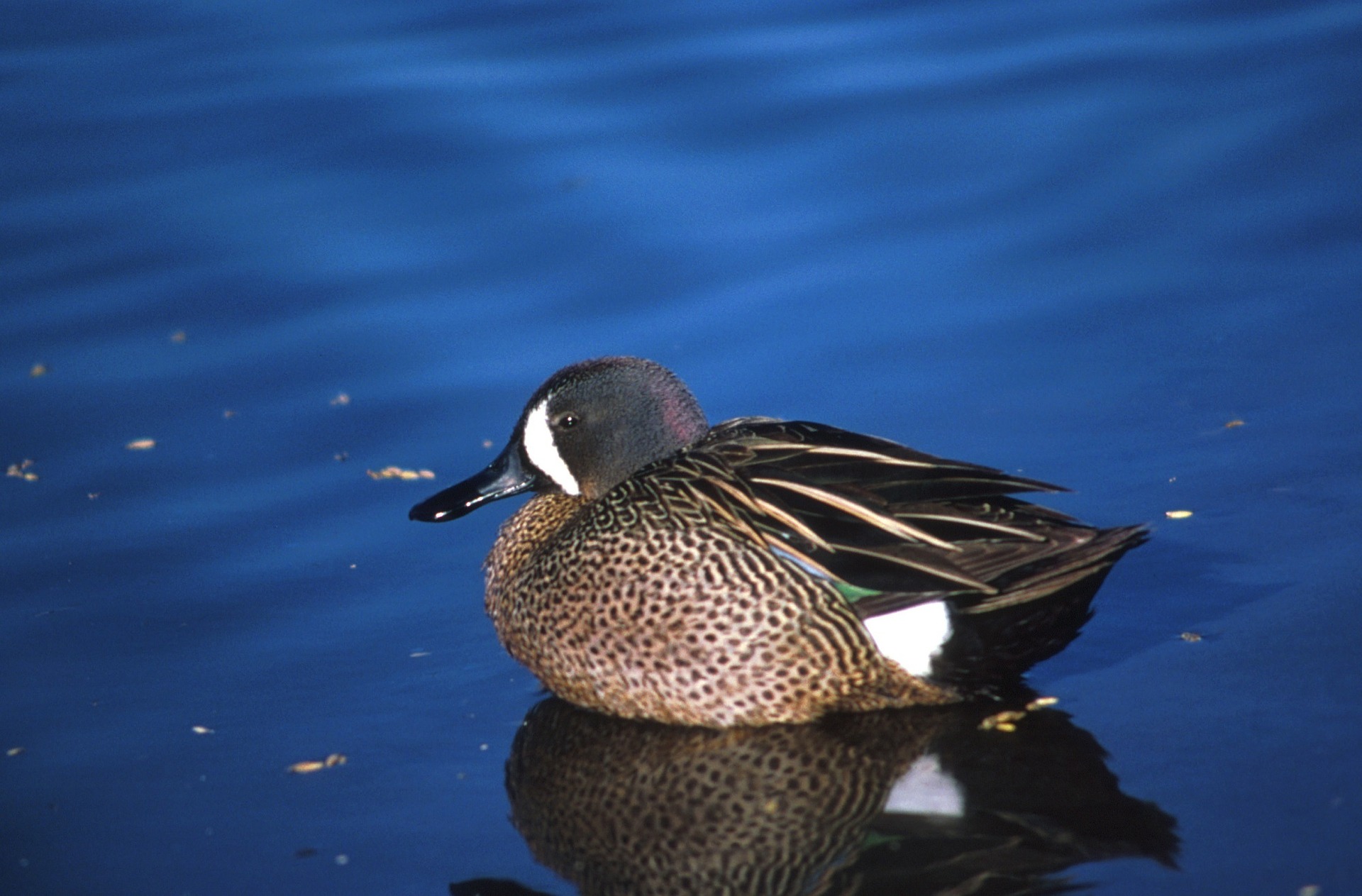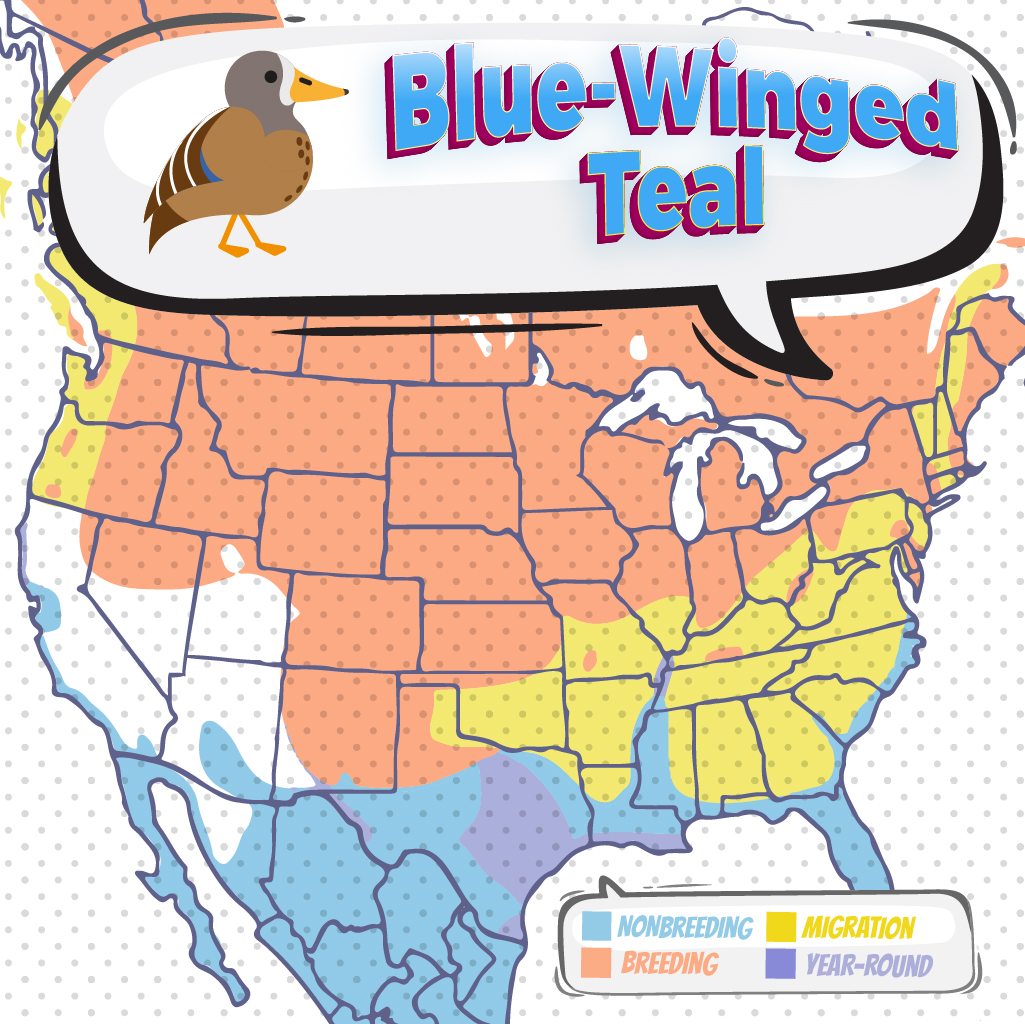
Blue Winged Teal
A Blue Winged Teal is a fun bird to see while bird watching. Below are some tips to help you identify Blue-Winged Teals. We have also put together a list of fun Blue-Winged Teal t-shirts, Blue-Winged Teal bird patches, birdhouses, bird feeders, binoculars, stickers, and other fun bird watching items.
About the Blue Winged Teal
This tiny bird which is part of the dabbling duck group is found in swamps and wet areas of North America and migrates to the Caribbean Islands and South America during winter. Their breeding grounds can be found in Canada and the United States. Some of their distinctive features include:
Description and Identification
A small dabbling duck, a Blue-winged Teal is dwarfed by a Mallard and only a touch larger than a Green-
winged Teal. Their head is rounded and the bill is on the large side. Breeding males are brown-bodied
with dark speckling on the breast, slaty-blue head with a white crescent behind the bill, and a small
white flank patch in front of their black rear. Females and eclipse males are cold, patterned brown. In-
flight, they reveal a bold powder-blue patch on their upper wing coverts.
These birds are small at a length of 16 inches with a wingspan of 23 inches. They have
rounded heads and large, black bills. Breeding males have brown bodies with dark
specklings on the breast, and a slaty-blue head with a white band behind the bill. They also
have a small white patch on front of their black rear. Females are a lighter shade of brown
with bold powder-blue patches that are on their upper-wing coverts.
Blue Winged Teal Color Pattern
The breeding males are primarily brown with dark spots on the breast. It has a slate-blue head with white on the sides, just behind the bill. The other eclipse males and females are buff with brown spotting and the underparts are buff and brown. In-flight, they reveal their yellow or orange legs.
Blue Winged Teal Size
The crown-sized duck is slightly larger than a Green-winged teal but dwarfed by a Mallard. They have a round-shaped head and a large bill.
Relative size for both sexes
- Length range: 14.2-16.1 in (36-41 cm)
- Weight: 8.1-19.2 oz (230-545 g)
- Wingspan range: 22.1-24.4 in (56-62 cm)

Blue Winged Teal Behavior
They feed by dabbling; either by dipping their entire head into the water or dipping their bill to reach for prey or vegetation. They are often found in groups around edges of a pound with vegetation and they rarely dive.
What Blue Winged Teal Eat
The Diet of blue-winged teals includes seeds, green plants, and aquatic invertebrates. At CuriOdyssey,
they are served waterfowl kibble, chopped greens, and worms. Blue-winged teals dabble to feed on the vegetative parts of aquatic plants (algae, duckweeds, pondweeds, etc.), seeds (sedges, pondweeds,
grasses, etc.), and large amounts of aquatic invertebrates found in shallowly flooded wetlands.
These ducks are omnivores and primarily feed on floating or shallowly submerged
vegetation and small aquatic animal life. Their vegetative diet mostly consists of seeds,
stems, grass, pondweed, smartweed, and duckweed. During the winter, seeds of rice, millet,
and waterlilies are the primary source of nutrition for these birds. Nearly a fourth of these
teals’ diets involve small aquatic life such as midge larvae, crustaceans, clams, snails,
mollusks, and other insects. While the females lay eggs, they require protein-rich diets and
rely on the aquatic life to provide the required nutrients.
They primarily feed on seeds of numerous glasses, smartweeds, pondweeds, and sedges. They also feed on various aquatic insects such as clams, midge larvae, and snails. Females will indulge in a high protein diet when laying. During winter, they predominantly feed on seeds of water lilies, millet, and wheat.
Where Blue Winged Teals Live
Blue-winged teal breed throughout the northeastern, central, and western United States, but bird
watchers in the southeastern states are most likely to see them during spring and fall migration and in
winter. Most blue-winged teal spends the winter south of the United States, as far as South America.
They are considered fair-weather ducks by many bird watchers because they stay far to the south until
spring is in full force. Perhaps it is their later spring arrival and their earlier fall departure that has earned
them the nicknames “summer teal” and “August teal.” Their preferred habitats at all seasons are
shallow, freshwater marshes and ponds.
Blue-Winged Teal is mainly found in prairies and parklands where they nest in grassy areas
with thick coverings for protection. During the summers, they forage in shallow ponds and
pond-marsh mixes. When they are flightless during the late summers, they mainly spend
time in large marshes and prairies. Migrants tend to use marshes, vegetated wetlands, and
rice fields and prefer freshwater or brackish water over saltwater bodies. They can be found
in shorelines far more than open water and tend to gravitate towards calm waters rather than
fast currents.
You can find blue-winged teal in calm water bodies such as small lakes and marshy areas. They prefer grassy wetlands as they breed and thrive in such habitats. The nest site can be several meters away from the nearest water, meadow, hayfield, or prairie.
Range and Migration

Blue-winged Teal are extremely rare in Washington during winter. They typically arrive in mid-April and
depart by the end of September, West of the Cascades. They are uncommon breeders, and their range is
somewhat limited to freshwater wetlands in the Puget Trough and coastal areas. In eastern Washington,
they are common in wetlands throughout the region. Blue-winged Teal are highly migratory and are, for
the most part, absent from the majority of North America during the cold months of the year. They
winter more extensively in South America than any other dabbler. They begin migrating later in spring
than other dabblers, with birds arriving on the coast as early as March, but mostly not before April and
May.
Blue-winged Teal are small ducks that are found along North and South America. These
migratory birds can be found breeding in regions of Canada and the United States during the
summer while wintering in Mexico, Central America, and warm regions of South America.
Apart from a small community between the south-western United States and north-western
Mexico, all birds are migratory. Their migratory routes often take them over open oceans and
they can sometimes be seen from many miles away. Ornithologists have observed that
some migrating flocks are composed entirely of juvenile birds, indicating that these routes
are instinctive behaviors and are not learned.
Blue Winged Teal Lifecycle
The female lays 9-13 eggs and incubates them for 23-24 days. After hatching, the young leave the nest after 24hrs. They search for their own food as the female tends to them. After a few weeks, the broods are left alone and are capable of flight after 38 days. They have an average lifespan of 12 years.
Blue Winged Teal Nesting
Females decide where to nest by flying over possible areas, landing in an opening, and then walking into
grassy cover. She may take several days to decide on the site. Males wait nearby. Nests are typically at
least a foot above the nearest water and covered by vegetation.
The female builds the nest by scraping with her feet to make a circular depression. She then lines it with
dried grasses picked from around the nest, adding down and breast feathers. Vegetation conceals most
nests on all sides and from above. The finished nest is about 8 inches across, with an inside diameter of
about 6 inches and 2 inches deep.
Nesting sites are decided by the females while males wait at nearby locations. The females
usually choose to nest in grassy covers close to water bodies, with the nest ideally being at
least a foot above the surface of the water while being surrounded by vegetation. The nest is
built by the female scraping her feet together to create a circular depression which is later
lined with dried grass along with down and breast feathers to insulate it. The vegetation
surrounding the nest is intended to cover it from all sides for maximum protection. They only
have one brood each breeding season with each clutch of eggs ranging from 6 – 14 eggs.
Ornithology
Bird Watching Academy & Camp Subscription Boxes
At Bird Watching Academy & Camp we help kids, youth, and adults get excited and involved in bird watching. We have several monthly subscription boxes that you can subscribe to. Our monthly subscription boxes help kids, youth, and adults learn about birds, bird watching, and bird conservation.
Bird Watching Binoculars for Identifying Blue Winged Teals
The most common types of bird watching binoculars for viewing Blue Winged Teals are 8×21 binoculars and 10×42 binoculars. Bird Watching Academy & Camp sells really nice 8×21 binoculars and 10×42 binoculars. You can view and purchase them here.
Blue Winged Teal T-shirts
If you love the Blue Winged Teal you should purchase a Bird Watching Academy & Camp T-shirt. To help support bird conservation we donate 10 percent to bird conservation activities.
Blue Winged Teal Iron On Patches
Kids, Youth, and Adults love to collect our Bird Watching Academy & Camp iron-on patches. Our bird-watching patches help you keep track of the birds you have seen and identified. You can also display the patches on our Bird Watching Academy & Camp banners.
The Blue-Winged Teal is a great iron-on patch to start your collection with. The patches are durable and can be sewn on or ironed on to just about anything.
Blue Winged Teal Stickers
Stickers are a great way for you to display your love for bird watching and the Blue Winged Teal. We sell a monthly subscription sticker pack. The sticker packs have 12 bird stickers. These sticker packs will help your kids learn new birds every month.
Bird Feeders For Blue Winged Teal
There are many types of bird feeders. Here are our favorite bird feeders for your backyard. We use all of these bird feeders currently. Kids will have a great time watching birds eat at these bird feeders. Using this collection of bird feeders will provide a wide variety and many types of birds.
Best Bird Houses for Blue Winged Teal
There are many types of birdhouses. Building a birdhouse is always fun but can be frustrating. These 4 birdhouses have become our favorites. Getting a birdhouse for kids to watch birds grow is always fun. We spent a little extra money on these birdhouses but they have been worth the higher price and look great.










